VHF in use
Tuesday, 10 January 2017
When you attend a course to gain an operator’s certificate you will learn to use a rather artificial form of speaking for making a call - e.g. to call another vessel you will select channel 16 and say the name of that vessel three times followed by the name of your vessel, then finish with “over” to indicate that you have finished and now expect a reply from him. So it will be something like “Aardvark, Aardvark, Aardvark, this is Bravobarge, over”, with the reply “Bravobarge this is Aardvark, over”. Channel 16 is reserved for calling and distress, so if Bravobarge was calling for a conversation he would then suggest a working channel for them to switch to. At the end of the communication the last caller would finish with “Roger, out”.
The official vocabulary for Continental inland waterway use is to be found here:
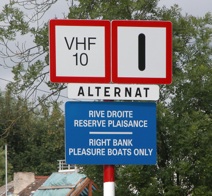
As noted there is a requirement at CEVNI Article 4.05.4 to call before entering blind sections, narrow channels or bridge openings. All that is generally required is for you to say where you are and your direction of travel. Arguably it is only the vessel travelling uphill/upstream that should do this, as it must not impede the passage of any vessel travelling downstream and needs to know if there are any. However the regulation does say “each vessel”.
As also noted sign 11b is sometimes used and indicates the channel to call on. Here and in the heading photo above it is ch.10 - would you really want to enter this narrow section without knowing that a loaded boat is steaming flat out towards you there? As it is also a one-way traffic section (alternat), how else do you know if it is clear for you to enter if you are not using VHF? I guess you just cross your fingers and hope for the best.
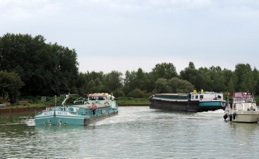
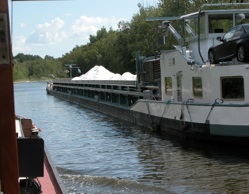
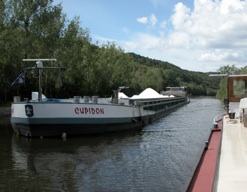
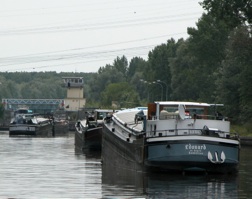
We have on a few occasions arrived at a busy lock where there are already a number of commercial vessels waiting. One of them has then called us on ch.10 to ask our length, and after a bit of chat between the various skippers they’ve come back and told us to go by as we will just fit with the 90m or whatever ship that is presently in the lock. Without that we would have been waiting for some considerable time - indeed I suspect that if we had no radio they would have simply ignored us after the initial unsuccessful attempt to make contact.
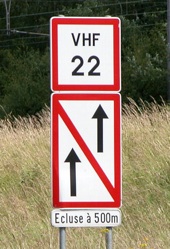
Even if you do not understand his reply at least he knows you are coming, and the chances are the lock will be ready. If he doesn’t say he’s getting the lock prepared he might be saying you have to wait as there are already boats in the lock and tell you which direction they are travelling in. He’s not going to be telling you to go away and to stop bothering him.
So in French the call might go:
-
•Écluse Pont Malin, écoutez-moi?
-
•Ouai, j’écoute.
-
•Bonjour monsieur/madame, j’ai un bateau vingt-quatre metres avalant, direction Belgique quinze minutes de vous, s’il vous plaît.
-
•J’ai un quatre-vingt metres montant dans l’écluse, puis il sera prêt pour vous.
-
•OK, merci monsieur/madame

At the end of the transit, as you leave the lock, it is then politesse to thank him:
-
•Merçi Pont Malin.
-
*OK, Bonne journée
If you try to add “Et vous”, or indeed anything further at all, he will then reply again to that - the French have so many ways to thank each other and you will never get the last word in.
link to Tam’s RYA Book of CEVNI Regulations and DVD Barge Handling in France
(All text and photographs copyright © Tam & Di Murrell unless otherwise credited)

